What are the symptoms of syringoma?
Syringoma is a benign skin condition characterized by small, flesh-colored or yellowish bumps that appear on the skin. The symptoms include:
- Small, Hard Bumps: Syringomas typically present as tiny, firm, skin-colored or yellowish papules. They are usually about 1 to 3 millimeters in diameter.
- Location: These bumps commonly appear on the eyelids, around the eyes, and sometimes on other areas of the face, neck, or upper chest.
- Texture: The bumps are often smooth and can feel slightly raised from the skin’s surface.
- Number: They can occur in clusters or groups, giving the appearance of multiple small bumps in one area.
Syringomas are generally asymptomatic and do not cause pain or itching. They are considered cosmetic concerns rather than medical issues. If there is uncertainty about the diagnosis or if the bumps change in appearance, it’s advisable to consult a healthcare provider for an evaluation.
What are the causes of syringoma?
The exact cause of syringoma is not well understood, but several factors may contribute to its development:
- Genetics: There may be a genetic component to syringoma, as it can sometimes run in families. Certain genetic conditions, such as Down syndrome, are associated with a higher incidence of syringomas.
- Hormonal Changes: Hormonal fluctuations, especially during puberty, pregnancy, or menopause, may play a role in the development of syringomas. This is supported by the fact that syringomas are more commonly observed in women and often appear during these periods of hormonal change.
- Sweat Gland Dysfunction: Syringomas are thought to originate from the sweat glands or their ducts. It is believed that a malfunction or abnormal development of these glands may lead to the formation of syringomas.
- Skin Type: There is some evidence that syringomas are more common in individuals with certain skin types, such as those with darker skin.
Despite these potential factors, the precise cause of syringomas remains unclear, and more research is needed to fully understand the underlying mechanisms.
What is the treatment for syringoma?
Treatment for syringoma is generally considered for cosmetic reasons, as the condition itself is benign and asymptomatic. Options for treatment include:
- Laser Therapy: Laser treatment, such as CO2 laser or erbium laser, can effectively remove syringomas by vaporizing the lesions. This method is often preferred for its precision and minimal scarring.
- Electrosurgery: Electrosurgical techniques involve using an electric current to cut or destroy the syringomas. This method is effective but may require multiple sessions.
- Cryotherapy: Cryotherapy involves freezing the syringomas with liquid nitrogen. This treatment can be effective, but it may cause temporary pigmentation changes or scarring.
- Excision: Surgical excision involves removing the syringomas with a scalpel. This method is typically used for larger or more persistent lesions and may result in scarring.
- Topical Treatments: Certain topical treatments, such as retinoids, may be used to reduce the appearance of syringomas, although they are generally less effective than other methods.
Each treatment option has its benefits and potential side effects, so it’s important to consult with a dermatologist or healthcare provider to determine the most appropriate approach based on the individual’s specific case and preferences.

Leave a Reply
You must be logged in to post a comment.